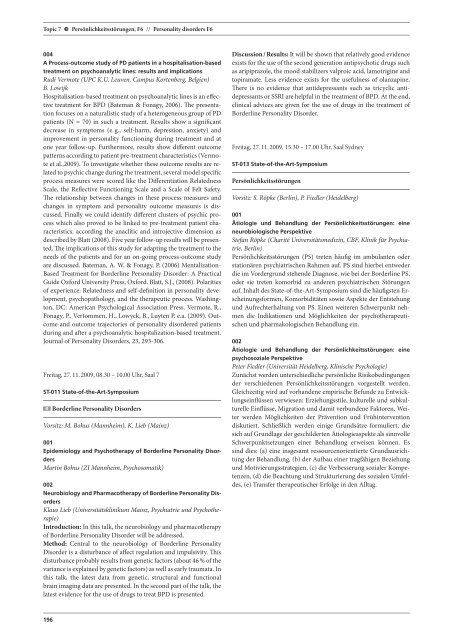Psychische Erkrankungen in der Lebensspanne ... - DGPPN
Psychische Erkrankungen in der Lebensspanne ... - DGPPN
Psychische Erkrankungen in der Lebensspanne ... - DGPPN
Erfolgreiche ePaper selbst erstellen
Machen Sie aus Ihren PDF Publikationen ein blätterbares Flipbook mit unserer einzigartigen Google optimierten e-Paper Software.
Topic 7 G Persönlichkeitsstörungen, F6 // Personality disor<strong>der</strong>s F6<br />
004<br />
A Process-outcome study of PD patients <strong>in</strong> a hospitalisation-based<br />
treatment on psychoanalytic l<strong>in</strong>es: results and implications<br />
Rudi Vermote (UPC K.U. Leuven, Campus Kortenberg, Belgien)<br />
B. Lowijk<br />
Hospitalisation-based treatment on psychoanalytic l<strong>in</strong>es is an effective<br />
treatment for BPD (Bateman & Fonagy, 2006). The presentation<br />
focuses on a naturalistic study of a heterogeneous group of PD<br />
patients (N = 70) <strong>in</strong> such a treatment. Results show a significant<br />
decrease <strong>in</strong> symptoms (e. g., self-harm, depression, anxiety) and<br />
improvement <strong>in</strong> personality function<strong>in</strong>g dur<strong>in</strong>g treatment and at<br />
one year follow-up. Furthermore, results show different outcome<br />
patterns accord<strong>in</strong>g to patient pre-treatment characteristics (Vermote<br />
et al.,2009). To <strong>in</strong>vestigate whether these outcome results are related<br />
to psychic change dur<strong>in</strong>g the treatment, several model specific<br />
process measures were scored like the Differentiation Relatedness<br />
Scale, the Reflective Function<strong>in</strong>g Scale and a Scale of Felt Safety.<br />
The relationship between changes <strong>in</strong> these process measures and<br />
changes <strong>in</strong> symptom and personality outcome measures is discussed.<br />
F<strong>in</strong>ally we could identify different clusters of psychic process<br />
which also proved to be l<strong>in</strong>ked to pre-treatment patient characteristics.<br />
accord<strong>in</strong>g the anaclitic and <strong>in</strong>trojective dimension as<br />
described by Blatt (2008). Five year follow-up results will be presented.<br />
The implications of this study for adapt<strong>in</strong>g the treatment to the<br />
needs of the patients and for an on-go<strong>in</strong>g process-outcome study<br />
are discussed. Bateman, A. W. & Fonagy, P. (2006) Mentalization-<br />
Based Treatment for Bor<strong>der</strong>l<strong>in</strong>e Personality Disor<strong>der</strong>: A Practical<br />
Guide Oxford University Press, Oxford. Blatt, S.J., (2008). Polarities<br />
of experience: Relatedness and self-def<strong>in</strong>ition <strong>in</strong> personality development,<br />
psychopathology, and the therapeutic process. Wash<strong>in</strong>gton,<br />
DC: American Psychological Association Press. Vermote, R.,<br />
Fonagy, P., Vertommen, H., Lowyck, B., Luyten P. e.a. (2009). Outcome<br />
and outcome trajectories of personality disor<strong>der</strong>ed patients<br />
dur<strong>in</strong>g and after a psychoanalytic hospitalization-based treatment.<br />
Journal of Personality Disor<strong>der</strong>s, 23, 293-306.<br />
Freitag, 27. 11. 2009, 08.30 – 10.00 Uhr, Saal 7<br />
ST-011 State-of-the-Art-Symposium<br />
196<br />
Bor<strong>der</strong>l<strong>in</strong>e Personality Disor<strong>der</strong>s<br />
Vorsitz: M. Bohus (Mannheim), K. Lieb (Ma<strong>in</strong>z)<br />
001<br />
Epidemiology and Psychotherapy of Bor<strong>der</strong>l<strong>in</strong>e Personality Disor<strong>der</strong>s<br />
Mart<strong>in</strong> Bohus (ZI Mannheim, Psychosomatik)<br />
002<br />
Neurobiology and Pharmacotherapy of Bor<strong>der</strong>l<strong>in</strong>e Personality Disor<strong>der</strong>s<br />
Klaus Lieb (Universitätskl<strong>in</strong>ikum Ma<strong>in</strong>z, Psychiatrie und Psychotherapie)<br />
Introduction: In this talk, the neurobiology and pharmacotherapy<br />
of Bor<strong>der</strong>l<strong>in</strong>e Personality Disor<strong>der</strong> will be addressed.<br />
Method: Central to the neurobiology of Bor<strong>der</strong>l<strong>in</strong>e Personality<br />
Disor<strong>der</strong> is a disturbance of affect regulation and impulsivity. This<br />
disturbance probably results from genetic factors (about 46 % of the<br />
variance is expla<strong>in</strong>ed by genetic factors) as well as early traumata. In<br />
this talk, the latest data from genetic, structural and functional<br />
bra<strong>in</strong> imag<strong>in</strong>g data are presented. In the second part of the talk, the<br />
latest evidence for the use of drugs to treat BPD is presented.<br />
Discussion / Results: It will be shown that relatively good evidence<br />
exists for the use of the second generation antipsychotic drugs such<br />
as aripiprazole, the mood stabilizers valproic acid, lamotrig<strong>in</strong>e and<br />
topiramate. Less evidence exists for the usefulness of olanzap<strong>in</strong>e.<br />
There is no evidence that antidepressants such as tricyclic antidepressants<br />
or SSRI are helpful <strong>in</strong> the treatment of BPD. At the end,<br />
cl<strong>in</strong>ical advices are given for the use of drugs <strong>in</strong> the treatment of<br />
Bor<strong>der</strong>l<strong>in</strong>e Personality Disor<strong>der</strong>.<br />
Freitag, 27. 11. 2009, 15.30 – 17.00 Uhr, Saal Sydney<br />
ST-013 State-of-the-Art-Symposium<br />
Persönlichkeitsstörungen<br />
Vorsitz: S. Röpke (Berl<strong>in</strong>), P. Fiedler (Heidelberg)<br />
001<br />
Ätiologie und Behandlung <strong>der</strong> Persönlichkeitsstörungen: e<strong>in</strong>e<br />
neurobiologische Perspektive<br />
Stefan Röpke (Charité Universitätsmediz<strong>in</strong>, CBF, Kl<strong>in</strong>ik für Psychiatrie,<br />
Berl<strong>in</strong>)<br />
Persönlichkeitsstörungen (PS) treten häufig im ambulanten o<strong>der</strong><br />
stationären psychiatrischen Rahmen auf. PS s<strong>in</strong>d hierbei entwe<strong>der</strong><br />
die im Vor<strong>der</strong>grund stehende Diagnose, wie bei <strong>der</strong> Bor<strong>der</strong>l<strong>in</strong>e PS,<br />
o<strong>der</strong> sie treten komorbid zu an<strong>der</strong>en psychiatrischen Störungen<br />
auf. Inhalt des State-of-the-Art-Symposium s<strong>in</strong>d die häufigsten Ersche<strong>in</strong>ungsformen,<br />
Komorbiditäten sowie Aspekte <strong>der</strong> Entstehung<br />
und Aufrechterhaltung von PS. E<strong>in</strong>en weiteren Schwerpunkt nehmen<br />
die Indikationen und Möglichkeiten <strong>der</strong> psychotherapeutischen<br />
und pharmakologischen Behandlung e<strong>in</strong>.<br />
002<br />
Ätiologie und Behandlung <strong>der</strong> Persönlichkeitsstörungen: e<strong>in</strong>e<br />
psychosoziale Perspektive<br />
Peter Fiedler (Universität Heidelberg, Kl<strong>in</strong>ische Psychologie)<br />
Zunächst werden unterschiedliche persönliche Risikobed<strong>in</strong>gungen<br />
<strong>der</strong> verschiedenen Persönlichkeitsstörungen vorgestellt werden.<br />
Gleichzeitig wird auf vorhandene empirische Befunde zu Entwicklungse<strong>in</strong>flüssen<br />
verwiesen: Erziehungsstile, kulturelle und subkulturelle<br />
E<strong>in</strong>flüsse, Migration und damit verbundene Faktoren. Weiter<br />
werden Möglichkeiten <strong>der</strong> Prävention und Früh<strong>in</strong>tervention<br />
diskutiert. Schließlich werden e<strong>in</strong>ige Grundsätze formuliert, die<br />
sich auf Grundlage <strong>der</strong> geschil<strong>der</strong>ten Ätiologieaspekte als s<strong>in</strong>nvolle<br />
Schwerpunktsetzungen e<strong>in</strong>er Behandlung erweisen können. Es<br />
s<strong>in</strong>d dies: (a) e<strong>in</strong>e <strong>in</strong>sgesamt ressourcenorientierte Grundausrichtung<br />
<strong>der</strong> Behandlung, (b) <strong>der</strong> Aufbau e<strong>in</strong>er tragfähigen Beziehung<br />
und Motivierungsstrategien, (c) die Verbesserung sozialer Kompetenzen,<br />
(d) die Beachtung und Strukturierung des sozialen Umfeldes,<br />
(e) Transfer therapeutischer Erfolge <strong>in</strong> den Alltag.


